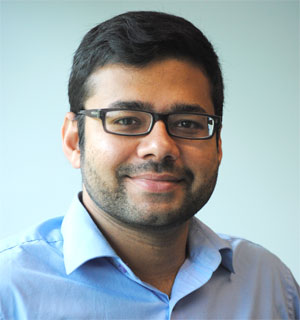About This Webinar
This webinar will provide an executive overview for leaders in imaging and ophthalmology on how artificial intelligence (AI) is transforming the field of medical imaging. Presenter Nishant Mohan will provide a hands-on demonstration of how to develop a deep-learning AI system from scratch, giving attendees critical insight into how to use this powerful tool.
Separating the hype from reality, Mohan will discuss essential concepts behind the revolutionizing power of AI. In addition, he will present critical factors in the ecosystem that is driving AI technology and major AI platforms. He will provide specific examples of the application of AI in optical coherence tomography (OCT) imaging and show how the combination of these two techniques promises to have a significant impact on our understanding and treatment of ophthalmic disorders — and how this could hold important lessons for similar applications.
About the presenter:

Nishant Mohan, Ph.D., is the vice president of the OCT Division at Wasatch Photonics. For more than a decade, he has actively participated in the development and commercialization of medical devices and digital imaging technologies. Mohan also serves on standing committees of SPIE, the international society for optics and photonics, and is a judge for the annual Prism Awards for innovation in optics, sponsored by SPIE and Photonics Media. Prior to joining Wasatch Photonics, Mohan was part of the research and development team of Bausch + Lomb Inc. in Rochester, N.Y., and a research fellow at Harvard Medical School. He received his doctorate in biomedical engineering at Boston University and his bachelor’s degree in electronics and communication engineering at Indian Institute of Technology (IIT) Guwahati.
Who should attend:
Executives, managers, engineers, researchers, clinicians, and technicians specializing in AI and/or medical imaging; educators; and anyone who is interested in learning more about the application of AI in ophthalmology and other areas of medical imaging will learn and benefit from this presentation.
Q & A with the presenter:
Can you recommend some books to read on DNN?
Deep Learning by Ian Goodfellow.
DNN is a kind of tool for classification. What AI algorithm(s) can you recommend for process optimization?
Note that DNN can be used for several tasks other than classification. It should be considered as a learning tool. Exact design of the network will depend on parameters to be optimized for the process.
Will AI be able to detect multiple diseases in scans, e.g. diabetic retinopathy and glaucoma?
Yes. Kermany et. al.
Cell 2018 discusses it.
What software knowledge is required?
It depends on how deep one wants to get into it. The key principles can be understood without much software knowledge.
Is there a way to determine the minimum number of images required for training, like how we determine sample size for prospective studies?
This is a good question. Note that training is performed prior to a prospective study. In general a trained neural network will be “locked” and then entered for study (see Abramoff et. al. 2018
Nature Medicine). This number should be taken to meet statistical significance. In the mentioned work 900 patients were taken. However, the number of training samples needed to build a good network still remains an open question. This is usually difficult to predict a priori. Most successful algorithms have taken images from standard databases on the order of 50,000-100,000. Note that transfer learning on existing neural networks can be used to reduce the amount of data needed.
Could you comment on the AI usage for detecting glaucoma? Recent references?
Please look at, Elze et. al.
J R Sco Interface 2015. Christopher et. al.
IVOS 2019. Shigueoka et. al.
PLoS 2018, Niwas et. al.
IEEE J of Biomed Health Inform 2016 (Anterior Segment).
What DL algorithm do you suggest for regression problems? Do you have any suggestions for a link?
It will depend on the amount and type of data available. A modified version of AlexNet can be a good choice.
Is possible for a DNN to self train?
It is usually called Q learning or reinforcement learning.
How can we measure subtle blood flow changes in retinal circulation?
There are OCT-based techniques for measuring blood flow. Some recent work has used deep learning for it as well.
Apart from accuracy, what are other measures of the quality of the a.i./cnn/DL algorithm that you use?
Algorithms should be general. They should use limited computational and memory resources. They should avoid overfitting.
How can I download the zip files that Nishant used for his demo on OCT and AI?
The zip file has:
1. Dataset.zip to be used as test dataset.
2. Setup guide for Google Colab, where the demonstration was shown.
3. Pdf file containing code. You can copy and paste code from here.
Here’s the zip file:
https://drive.google.com/open?id=1gNUE4Aa7KAD_pV-lkE-wt0Eq6-NtUmLJ
For those who may needed additional directions, here are the exact steps:
1. Go to the Google drive link provided.
2. Click on the download button on the right side (the one with down arrow).
3. Press “download anyway” on the next screen.
4. Once the zip file is downloaded, double click on it to extract it.
Read AO-OCT Comes into Focus by Nishant Mohan and Cicely Rathmell, Wasatch Photonics (BioPhotonics, March 2019).
Also by Nishant Mohan: Vying for Dominance: Swept-Source vs. Spectral-Domain OCT (BioPhotonics, April 2018) and Advances in Optical Coherence Tomography (Photonics Spectra, Oct. 2018).